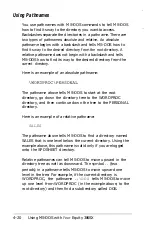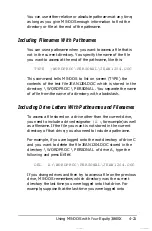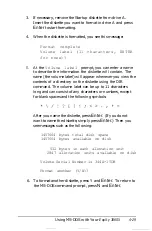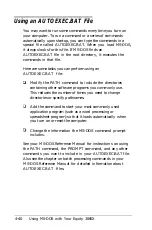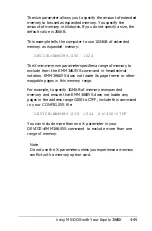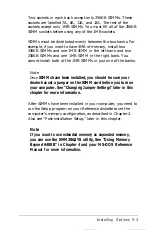
4.
If necessary, remove the Startup diskette from drive A.
Insert the diskette you want to copy from (the source
diskette) into drive A and the diskette you want to copy to
(the target diskette) into drive B. Then press any key to
begin copying. If the target diskette is not formatted,
DISKCOPY formats it before copying data to it.
5. When the copy is complete, you see this message:
Copy another diskette (Y/N)?
Press Y to copy another diskette or
N
to return to the
MS-DOS command prompt.
Using the BACKUP Command
Use the BACKUP command to back up the data on your hard
disk. It provides a convenient and efficient way to copy the files
on the hard disk to diskettes. BACKUP allows you to do the
following:
Split large files across two or more diskettes
Copy only those files that have been modified since the
most recent backup (with the /M switch)
Copy only those files that have been created (or modified)
after a specified date (with the /D switch)
Copy files in the current directory together with files in all
subdirectories of the current directory (with the /S switch)
Automatically format diskettes before copying files.
Unlike COPY, XCOPY, and DISKCOPY, which make readable
copies of files, BACKUP creates files that you cannot access
directly. To return files copied with the BACKUP command to
the hard disk, you need to use the RESTORE command.
4-34
Using
MS-DOS
with
Your Equity 386SX
Summary of Contents for Equity 386SX PLUS
Page 1: ...m u cl3 0 z E 5 J I 1 al y 8 c 7 5 w ii u l X ...
Page 4: ...EPSON E Q U I T Y 3 8 6 S X User s Guide Y19299100100 ...
Page 20: ...6 Introduction ...
Page 38: ...1 18 Setting Up Your System ...
Page 69: ......
Page 70: ...2 32 Running the Setup Program ...
Page 96: ... 7 R _ ri h 14 3 26 Using the Equity 386SX ...
Page 168: ...5 26 dling Options ...
Page 192: ...B 4 Power on Diagnostics ...
Page 232: ...C 40 Performing System Diagnostics ...
Page 246: ... D 14 Physically Formatting a Hard Disk ...
Page 250: ...E 4 Hard Disk Drive Types ...
Page 282: ...8 I n d e x ...
Page 284: ......

